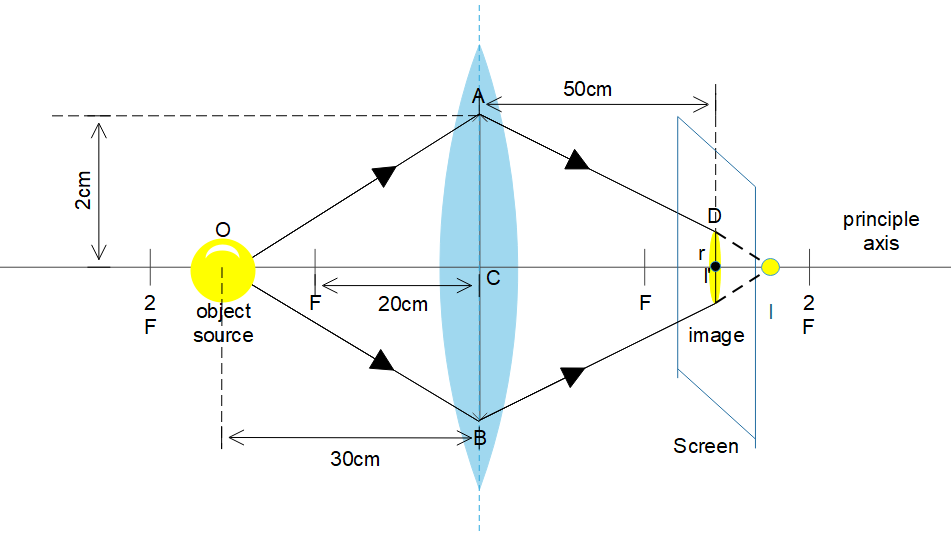Question
Question: A lens of focal length \(20.0cm\) and aperture radius \(2.0cm\) is placed at a distance \(30.0cm\) f...
A lens of focal length 20.0cm and aperture radius 2.0cm is placed at a distance 30.0cm from a point source of light. On the other side a screen is placed at a distance 50.0cm from the lens. The radius of the spot of the light formed on the screen is ……..... (neglect spherical aberration through lens)
\eqalign{
& A.\,\,\dfrac{1}{2}cm \cr
& B.\,\,\dfrac{1}{3}cm \cr
& C.\,\,\dfrac{1}{5}cm \cr
& D.\,1.0cm \cr}
Solution
First, we have to understand that the image is formed on the screen. As the screen is acting as an obstacle. But the thin lens formula still applies for the original image. The radius of the light spot is actually the height of the image from the principal axis.
Formula used:
v1=f1−u1
Complete answer:
From the information given in the question, let’s sketch a diagram.

In the diagram,
O is the light source (object)
I is the original image
I′ is the image formed on the screen
AC is the radius of aperture
DI′(r) is the radius of the light spot on the screen
CI is the image distance
OC is the object distance
OF is the focal length.
We have to understand that, here the image is meant to form at I. But the screen acts as interruption and the image is formed on the screen at I’ instead of forming at point I.
According to thin lens formula
f1=v1+u1⇒v1=f1−u1
Where:
v is the Image distance
u is the object distance
f is the focal length
Using this formula and the object distance is u = 30.0 cm and the focal length is f = 20cm, we have
\eqalign{
& \dfrac{1}{v} = \dfrac{1}{f} - \dfrac{1}{u} = \dfrac{1}{{20}} - \dfrac{1}{{30}} = \dfrac{1}{{60}} \cr
& \therefore v = 60cm \cr}
Consider ΔACI and ΔDI′I, from the diagram. From properties of similar triangles, we have
\eqalign{
& \dfrac{{AC}}{{CI}} = \dfrac{{D{I'}}}{{{I'}I}} \Rightarrow D{I'} = \dfrac{{AC}}{{CI}} \times {I'}I \cr
& \Rightarrow D{I'} = \dfrac{{2cm}}{{60cm}} \times 10cm = \dfrac{1}{3}cm \cr
& \therefore r = \dfrac{1}{3}cm \cr}
So, the correct answer is “Option B”.
Note:
As the lenses we have considered are converging lenses, the sign convention is such that focal length is always positive. Also remember that, we consider OF as the focal length. Simply put, all distances should be measured from the optical center. Distances measured in the direction of the incident rays are positive.
